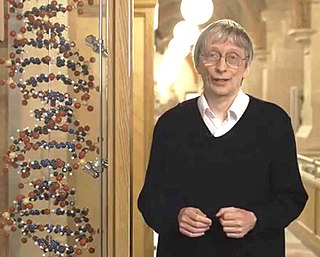Related Research Articles
The Copenhagen interpretation is a collection of views about the meaning of quantum mechanics, stemming from the work of Niels Bohr, Werner Heisenberg, Max Born, and others. The term "Copenhagen interpretation" was apparently coined by Heisenberg during the 1950s to refer to ideas developed in the 1925–1927 period, glossing over his disagreements with Bohr. Consequently, there is no definitive historical statement of what the interpretation entails.

David Elieser Deutsch is a British physicist at the University of Oxford. He is a visiting professor in the Department of Atomic and Laser Physics at the Centre for Quantum Computation (CQC) in the Clarendon Laboratory of the University of Oxford. He pioneered the field of quantum computation by formulating a description for a quantum Turing machine, as well as specifying an algorithm designed to run on a quantum computer. He is a proponent of the many-worlds interpretation of quantum mechanics.

The many-worlds interpretation (MWI) is a philosophical position about how the mathematics used in quantum mechanics relates to physical reality. It asserts that the universal wavefunction is objectively real, and that there is no wave function collapse. This implies that all possible outcomes of quantum measurements are physically realized in some "world" or universe. In contrast to some other interpretations, the evolution of reality as a whole in MWI is rigidly deterministic and local. Many-worlds is also called the relative state formulation or the Everett interpretation, after physicist Hugh Everett, who first proposed it in 1957. Bryce DeWitt popularized the formulation and named it many-worlds in the 1970s.

The multiverse is the hypothetical set of all universes. Together, these universes are presumed to comprise everything that exists: the entirety of space, time, matter, energy, information, and the physical laws and constants that describe them. The different universes within the multiverse are called "parallel universes", "flat universes", "other universes", "alternate universes", "multiple universes", "plane universes", "parent and child universes", "many universes", or "many worlds". One common assumption is that the multiverse is a "patchwork quilt of separate universes all bound by the same laws of physics."

Quantum mechanics is a fundamental theory in physics that describes the behavior of nature at and below the scale of atoms. It is the foundation of all quantum physics, which includes quantum chemistry, quantum field theory, quantum technology, and quantum information science.

A quantum computer is a computer that takes advantage of quantum mechanical phenomena.

Quantum information is the information of the state of a quantum system. It is the basic entity of study in quantum information theory, and can be manipulated using quantum information processing techniques. Quantum information refers to both the technical definition in terms of Von Neumann entropy and the general computational term.

Quantum entanglement is the phenomenon of a group of particles being generated, interacting, or sharing spatial proximity in such a way that the quantum state of each particle of the group cannot be described independently of the state of the others, including when the particles are separated by a large distance. The topic of quantum entanglement is at the heart of the disparity between classical and quantum physics: entanglement is a primary feature of quantum mechanics not present in classical mechanics.
In physics, string theory is a theoretical framework in which the point-like particles of particle physics are replaced by one-dimensional objects called strings. String theory describes how these strings propagate through space and interact with each other. On distance scales larger than the string scale, a string looks just like an ordinary particle, with its mass, charge, and other properties determined by the vibrational state of the string. In string theory, one of the many vibrational states of the string corresponds to the graviton, a quantum mechanical particle that carries the gravitational force. Thus, string theory is a theory of quantum gravity.

A theory of everything (TOE), final theory, ultimate theory, unified field theory or master theory is a hypothetical, singular, all-encompassing, coherent theoretical framework of physics that fully explains and links together all aspects of the universe. Finding a theory of everything is one of the major unsolved problems in physics.
In quantum mechanics, counterfactual definiteness (CFD) is the ability to speak "meaningfully" of the definiteness of the results of measurements that have not been performed. The term "counterfactual definiteness" is used in discussions of physics calculations, especially those related to the phenomenon called quantum entanglement and those related to the Bell inequalities. In such discussions "meaningfully" means the ability to treat these unmeasured results on an equal footing with measured results in statistical calculations. It is this aspect of counterfactual definiteness that is of direct relevance to physics and mathematical models of physical systems and not philosophical concerns regarding the meaning of unmeasured results.
The Novikov self-consistency principle, also known as the Novikov self-consistency conjecture and Larry Niven's law of conservation of history, is a principle developed by Russian physicist Igor Dmitriyevich Novikov in the mid-1980s. Novikov intended it to solve the problem of paradoxes in time travel, which is theoretically permitted in certain solutions of general relativity that contain what are known as closed timelike curves. The principle asserts that if an event exists that would cause a paradox or any "change" to the past whatsoever, then the probability of that event is zero. It would thus be impossible to create time paradoxes.
An interpretation of quantum mechanics is an attempt to explain how the mathematical theory of quantum mechanics might correspond to experienced reality. Although quantum mechanics has held up to rigorous and extremely precise tests in an extraordinarily broad range of experiments, there exist a number of contending schools of thought over their interpretation. These views on interpretation differ on such fundamental questions as whether quantum mechanics is deterministic or stochastic, local or non-local, which elements of quantum mechanics can be considered real, and what the nature of measurement is, among other matters.
In philosophy, the philosophy of physics deals with conceptual and interpretational issues in modern physics, many of which overlap with research done by certain kinds of theoretical physicists. Historically, philosophers of physics have engaged with questions such as the nature of space, time, matter and the laws that govern their interactions, as well as the epistemological and ontological basis of the theories used by practicing physicists. The discipline draws upon insights from various areas of philosophy, including metaphysics, epistemology, and philosophy of science, while also engaging with the latest developments in theoretical and experimental physics.

In the history of science, Laplace's demon was a notable published articulation of causal determinism on a scientific basis by Pierre-Simon Laplace in 1814. According to determinism, if someone knows the precise location and momentum of every atom in the universe, their past and future values for any given time are entailed; they can be calculated from the laws of classical mechanics.
In the mathematical study of logic and the physical analysis of quantum foundations, quantum logic is a set of rules for manipulation of propositions inspired by the structure of quantum theory. The formal system takes as its starting point an observation of Garrett Birkhoff and John von Neumann, that the structure of experimental tests in classical mechanics forms a Boolean algebra, but the structure of experimental tests in quantum mechanics forms a much more complicated structure.
In theoretical physics, the problem of time is a conceptual conflict between general relativity and quantum mechanics in that quantum mechanics regards the flow of time as universal and absolute, whereas general relativity regards the flow of time as malleable and relative. This problem raises the question of what time really is in a physical sense and whether it is truly a real, distinct phenomenon. It also involves the related question of why time seems to flow in a single direction, despite the fact that no known physical laws at the microscopic level seem to require a single direction.

Quantum Reality is a 1985 popular science book by physicist Nick Herbert, a member of the Fundamental Fysiks Group which was formed to explore the philosophical implications of quantum theory. The book attempts to address the ontology of quantum objects, their attributes, and their interactions, without reliance on advanced mathematical concepts. Herbert discusses the most common interpretations of quantum mechanics and their consequences in turn, highlighting the conceptual advantages and drawbacks of each.

Giacomo Mauro D'Ariano is an Italian quantum physicist. He is a professor of theoretical physics at the University of Pavia, where he is the leader of the QUIT group. He is a member of the Center of Photonic Communication and Computing at Northwestern University; a member of the Istituto Lombardo Accademia di Scienze e Lettere; and a member of the Foundational Questions Institute (FQXi).
Chiara Marletto is a theoretical physicist at Wolfson College, Oxford. She is a pioneer in the field of constructor theory, counterfactuals and a generalization of the quantum theory of information.
References
- 1 2 Heaven, Douglas (6 November 2012). "Theory of everything says universe is a transformer". New Scientist. Reed Business Information. Retrieved 11 January 2016.
- ↑ Merali, Zeeya (26 May 2014). "A Meta-Law to Rule Them All: Physicists Devise a "Theory of Everything"". Scientific American. Nature Publishing Group. Retrieved 11 January 2016.
- 1 2 3 4 Deutsch, David; Marletto, Chiara (17 December 2014). "Constructor theory of information". Proceedings of the Royal Society A. 471 (2174): 20140540. arXiv: 1405.5563 . Bibcode:2014RSPSA.47140540D. doi:10.1098/rspa.2014.0540. PMC 4309123 . PMID 25663803.
- 1 2 3 4 5 6 7 8 9 Deutsch, David; Marletto, Chiara (24 May 2014). "Why we need to reconstruct the universe". New Scientist . pp. 30–31.
- ↑ "CONSTRUCTOR THEORY: A Conversation with David Deutsch". Edge. 22 October 2012. Retrieved 20 July 2014.
- ↑ Marletto, Chiara (14 January 2015). "Constructor Theory of Life". Journal of the Royal Society Interface. 12 (104): 20141226. arXiv: 1407.0681 . doi:10.1098/rsif.2014.1226. PMC 4345487 . PMID 25589566.
- ↑ Marletto, Chiara (16 July 2015). "Life without design". Aeon. Aeon Media Pty. Limited. Retrieved 23 May 2016.
Constructor theory is a new vision of physics, but it helps to answer a very old question: why is life possible at all?